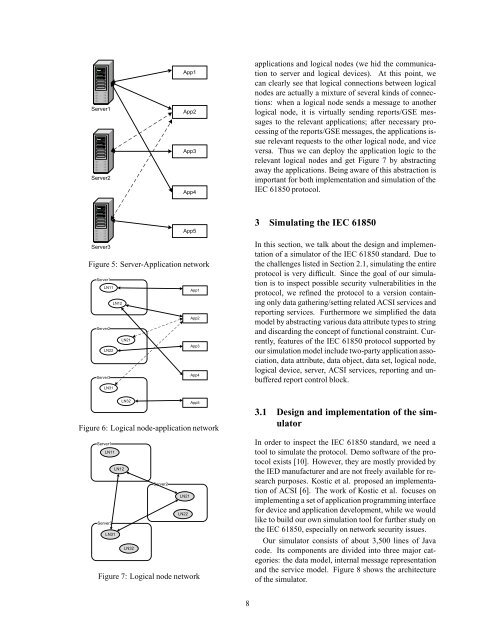Understanding and Simulating the IEC 61850 Standard - CiteSeerX
Understanding and Simulating the IEC 61850 Standard - CiteSeerX
Understanding and Simulating the IEC 61850 Standard - CiteSeerX
You also want an ePaper? Increase the reach of your titles
YUMPU automatically turns print PDFs into web optimized ePapers that Google loves.
Server1<br />
Server2<br />
App1<br />
App2<br />
App3<br />
App4<br />
applications <strong>and</strong> logical nodes (we hid <strong>the</strong> communication<br />
to server <strong>and</strong> logical devices). At this point, we<br />
can clearly see that logical connections between logical<br />
nodes are actually a mixture of several kinds of connections:<br />
when a logical node sends a message to ano<strong>the</strong>r<br />
logical node, it is virtually sending reports/GSE messages<br />
to <strong>the</strong> relevant applications; after necessary processing<br />
of <strong>the</strong> reports/GSE messages, <strong>the</strong> applications issue<br />
relevant requests to <strong>the</strong> o<strong>the</strong>r logical node, <strong>and</strong> vice<br />
versa. Thus we can deploy <strong>the</strong> application logic to <strong>the</strong><br />
relevant logical nodes <strong>and</strong> get Figure 7 by abstracting<br />
away <strong>the</strong> applications. Being aware of this abstraction is<br />
important for both implementation <strong>and</strong> simulation of <strong>the</strong><br />
<strong>IEC</strong> <strong>61850</strong> protocol.<br />
App5<br />
Server3<br />
Figure 5: Server-Application network<br />
Server1<br />
LN11<br />
App1<br />
LN12<br />
App2<br />
Server2<br />
LN21<br />
App3<br />
LN22<br />
App4<br />
Server3<br />
LN31<br />
3 <strong>Simulating</strong> <strong>the</strong> <strong>IEC</strong> <strong>61850</strong><br />
In this section, we talk about <strong>the</strong> design <strong>and</strong> implementation<br />
of a simulator of <strong>the</strong> <strong>IEC</strong> <strong>61850</strong> st<strong>and</strong>ard. Due to<br />
<strong>the</strong> challenges listed in Section 2.1, simulating <strong>the</strong> entire<br />
protocol is very difficult. Since <strong>the</strong> goal of our simulation<br />
is to inspect possible security vulnerabilities in <strong>the</strong><br />
protocol, we refined <strong>the</strong> protocol to a version containing<br />
only data ga<strong>the</strong>ring/setting related ACSI services <strong>and</strong><br />
reporting services. Fur<strong>the</strong>rmore we simplified <strong>the</strong> data<br />
model by abstracting various data attribute types to string<br />
<strong>and</strong> discarding <strong>the</strong> concept of functional constraint. Currently,<br />
features of <strong>the</strong> <strong>IEC</strong> <strong>61850</strong> protocol supported by<br />
our simulation model include two-party application association,<br />
data attribute, data object, data set, logical node,<br />
logical device, server, ACSI services, reporting <strong>and</strong> unbuffered<br />
report control block.<br />
LN32<br />
App5<br />
Figure 6: Logical node-application network<br />
Server1<br />
LN11<br />
LN12<br />
Server2<br />
LN21<br />
LN22<br />
Server3<br />
LN31<br />
LN32<br />
Figure 7: Logical node network<br />
3.1 Design <strong>and</strong> implementation of <strong>the</strong> simulator<br />
In order to inspect <strong>the</strong> <strong>IEC</strong> <strong>61850</strong> st<strong>and</strong>ard, we need a<br />
tool to simulate <strong>the</strong> protocol. Demo software of <strong>the</strong> protocol<br />
exists [10]. However, <strong>the</strong>y are mostly provided by<br />
<strong>the</strong> IED manufacturer <strong>and</strong> are not freely available for research<br />
purposes. Kostic et al. proposed an implementation<br />
of ACSI [6]. The work of Kostic et al. focuses on<br />
implementing a set of application programming interface<br />
for device <strong>and</strong> application development, while we would<br />
like to build our own simulation tool for fur<strong>the</strong>r study on<br />
<strong>the</strong> <strong>IEC</strong> <strong>61850</strong>, especially on network security issues.<br />
Our simulator consists of about 3,500 lines of Java<br />
code. Its components are divided into three major categories:<br />
<strong>the</strong> data model, internal message representation<br />
<strong>and</strong> <strong>the</strong> service model. Figure 8 shows <strong>the</strong> architecture<br />
of <strong>the</strong> simulator.<br />
8
















